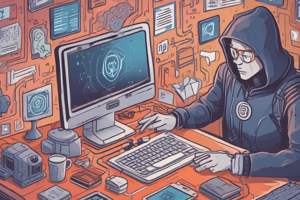Podcast
Questions and Answers
What is the primary objective of a hacker?
What is the primary objective of a hacker?
Which type of perpetrator primarily seeks financial gain through illegal activities?
Which type of perpetrator primarily seeks financial gain through illegal activities?
What distinguishes a black hat hacker from a white hat hacker?
What distinguishes a black hat hacker from a white hat hacker?
Which type of perpetrator is characterized by having a significant level of resources and training?
Which type of perpetrator is characterized by having a significant level of resources and training?
Signup and view all the answers
What is the level of risk associated with a cyberterrorist's actions?
What is the level of risk associated with a cyberterrorist's actions?
Signup and view all the answers
Which of the following describes an industrial spy?
Which of the following describes an industrial spy?
Signup and view all the answers
What type of criminal engages in identity theft and phishing online?
What type of criminal engages in identity theft and phishing online?
Signup and view all the answers
What is the main intent of a computer virus?
What is the main intent of a computer virus?
Signup and view all the answers
How does a worm differ from a virus?
How does a worm differ from a virus?
Signup and view all the answers
What action do cyberterrorists typically take?
What action do cyberterrorists typically take?
Signup and view all the answers
What characterizes a distributed denial-of-service (DDoS) attack?
What characterizes a distributed denial-of-service (DDoS) attack?
Signup and view all the answers
What is a key feature of a logic bomb?
What is a key feature of a logic bomb?
Signup and view all the answers
What is the primary purpose of a Trojan horse in computing?
What is the primary purpose of a Trojan horse in computing?
Signup and view all the answers
Which of these statements about cybercriminals is true?
Which of these statements about cybercriminals is true?
Signup and view all the answers
What legal measure protects trade secrets in the United States?
What legal measure protects trade secrets in the United States?
Signup and view all the answers
What is a primary function of computer hardware?
What is a primary function of computer hardware?
Signup and view all the answers
Which device is considered input hardware?
Which device is considered input hardware?
Signup and view all the answers
What is the function of output hardware?
What is the function of output hardware?
Signup and view all the answers
How is data primarily measured in computing?
How is data primarily measured in computing?
Signup and view all the answers
Which of the following describes a bit?
Which of the following describes a bit?
Signup and view all the answers
What role does software play in a computer system?
What role does software play in a computer system?
Signup and view all the answers
What is the purpose of secondary storage hardware?
What is the purpose of secondary storage hardware?
Signup and view all the answers
Which statement accurately describes data in computing?
Which statement accurately describes data in computing?
Signup and view all the answers
What defines a user in the context of a computer system?
What defines a user in the context of a computer system?
Signup and view all the answers
Which of the following is an example of processing and memory hardware?
Which of the following is an example of processing and memory hardware?
Signup and view all the answers
Study Notes
Computer Threats
- A computer threat is any person or thing that could harm or endanger data or a system.
- Threats can involve removing, stealing, or manipulating data
Computer Crimes
- Computer crimes violate the law and can be prosecuted by the state.
Perpetrators of Computer Crime
- Perpetrators are individuals or groups who commit computer crimes
- Perpetrators have different objectives, motives, and resources
Hacker
- A hacker tests the limitations of systems out of intellectual curiosity.
- White hat hackers use their skills for good.
- A cracker breaks system security for malicious intent.
- Black hat hackers use their skills for malicious activity.
Malicious Insiders
- Insiders are a security concern for companies.
- An insider can be an employee, consultant, or contractor who exploits internal system knowledge.
Industrial Spies
- Industrial spies illegally acquire trade secrets from competitors.
- The Economic Espionage Act of 1996 protects trade secrets.
Cybercriminals
- Cybercriminals use the internet to commit crimes like identify theft, spamming, phishing, and fraud.
Cyberterrorists
- Cyberterrorists use computers and networks to influence governments or advance political or social objectives.
Threats
Virus
- A virus is malicious program that harms or disables systems.
- It spreads from file to file on a computer.
Worm
- A worm is a self-executing program that spreads from computer to computer.
- It does not spread from file to file like a virus.
Trojan Horse
- A Trojan Horse is a harmful program disguised as a legitimate file.
- Often, a user downloads a Trojan Horse believing it to be safe.
Distributed Denial-of-Service (DDoS)
- A DDoS attack floods a server with traffic to prevent users from accessing online services.
Logic Bomb
- A logic bomb is malicious code that triggers an attack when specific condition are met.
Phishing
- Phishing involves stealing sensitive information, such as login credentials, credit card details, or bank account information.
- The goal of phishing is often to use or sell stolen information.
Ransomware
- Ransomware restricts access to a computer, typically through encryption.
- Victims must pay a ransom to regain access to their files.
Spam
- Spam is unsolicited, often irrelevant or inappropriate messages sent over the internet.
- Spam is used for advertising, phishing, malware distribution, or other purposes.
Adware
- Adware is software that displays pop-up advertisements on a computer or mobile device.
- It can become malicious by slowing devices, hijacking browsers, and installing viruses or spyware.
Spyware
- Spyware is malicious software that collects data from a user's device and sends it to third parties without their consent.
- The goal of spyware is to spy on users and collect information.
What is a Computer?
- A computer is an electronic device that can receive, store, process data, and deliver information.
Computer Hardware
- Input Hardware: Used to input data into the computer system. Examples include keyboards, mice, scanners, joysticks, microphones, webcams, and barcode readers.
- Output Hardware: Used to display the results of data processing. Examples include monitors, printers, speakers, projectors, and headphones.
- Processing & Memory Hardware: Used to process data and information to complete tasks. Examples include the processor (CPU) and RAM.
- Secondary Storage Hardware: Used to permanently store data. Examples include hard disks, solid-state drives, and pen drives.
Computer Software
- Software: Collection of computer programs, procedures, and documentation that perform different tasks on a computer system.
- Application Software: Performs specific tasks.
- System Software: Coordinates the activities of a computer.
Data & Measurement
- Data: One or multiple sets of information used in a process to obtain a targeted result or goal. It's raw facts and figures that need to be input into the computer.
- Byte: The unit of measurement for data. Each byte consists of 8 bits.
- Bit: The smallest unit of data a computer can process and store. Equivalent to a light switch being ON/OFF.
Computer Users
- User: Person who uses, maintains, and manipulates a computer.
- Peopleware: The human role in an IT system.
Studying That Suits You
Use AI to generate personalized quizzes and flashcards to suit your learning preferences.
Description
Explore the various computer threats and crimes that can compromise data and systems. This quiz covers topics including hackers, malicious insiders, and the motivations behind computer crimes. Test your knowledge of these critical cybersecurity concepts!




